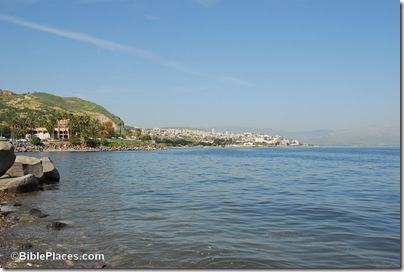The most important city in Galilee in the 1st century A.D. was Tiberias. Founded by Herod Antipas in 20 A.D. and named after the emperor, Tiberius, the city served as the capital of the region. In the New Testament, the Sea of Galilee is several times referred to as the “Sea of Tiberias,” indicating the city’s importance. But for two reasons most Christian tourists to Israel don’t know much about it. First, there is no record that Jesus ever visited the city. None of his miracles or sermons here, if he did any, are written down. Second, Tiberias today is the largest city in Galilee, and modern populations and ancient ruins don’t like each other. But in the last few years, excavations of the ancient city have been taking place in areas not yet covered by apartment buildings and shopping malls. This week, the Israel Antiquities Authority announced a plan to open an archaeological park to feature the Roman city. The press release is posted in full here with a few photos, and some extracts are posted below. The Jerusalem Post has the story in briefer form here.
Berko Park is slated to be magnet that will attract tourism from Israel and abroad to Tiberias and will expose the public at large to Tiberias’ glorious past, through all of its history which has its beginnings in the Early Roman period 2,000 years ago….
Berko Park extends across an area of approximately 100 dunams and is replete with ancient remains of the city of Tiberias that date from the time of the city’s establishment by Herod Antipas in the 1st century CE until the time of the Fatimid dynasty in the 11th century CE….
It is anticipated that the work in this part of the park will be finished this coming summer. Within the framework of the future expansion of Berko Park the Roman theater, which is located at the foot of Mount Berenice, is slated to be excavated. The theater is built of stone, is of imposing in size and faces east, thus those seated in it viewed the Sea of Galilee opposite them, the Golan Heights and Mount Hermon. The planners envision that this ancient and impressive theater will be used once again in modern times for the presentation of grandiose performances….
Berko Park is part of a more extensive area where there are important archaeological finds that are all expected to be included in a large archaeological park in which there are ancient buildings that were previously excavated and that stand exposed today in the area. Included among them are the beit hamidrash that is ascribed to Rabbi Yochanan, which was exposed in the area of Tiberias’ waste water purification plant, the Anchor Church on Mount Berenice, another Byzantine church structure that was recently uncovered, the cardo, the marketplace, the aqueduct and the water reservoir. The city of Tiberias and the Israel Antiquities Authority will continue to act to rehabilitate and conserve these ancient structures, and to include them in a wide-scale tourism program.
